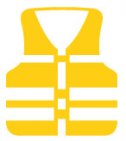You are in: Home
> Resources
> Boating Rules
> Lifejacket Rules
Lifejackets Save Lives
Lifejackets are an important safety item. Lifejacket requirements can vary depending on the type of vessel being used. You must either carry or wear a lifejacket on board all registered vessels. It should also be the correct size for the wearer and in good condition. All States currently have a zero-tolerance approach to lifejacket compliance when boating. As a vessel owner or skipper, you can attract serious penalties if not carrying lifejackets, or if there aren't enough lifejackets for everyone on board.

Lifejackets are a Legal Requirement
You must carry a correctly sized, serviceable lifejacket for each person on board a recreation vessel. They must be stored or placed to allow quick and easy access. If you plan to go boating in another state, don't forget to check out the local lifejacket rules before heading out.
×
Minimum Requirements
- By children less than 12 years of age when in a vessel less than 4.8 metres in length or when in an open area of a vessel less than 8 metres in length that is underway.
- By all the occupants of a vessel less than 4.8m in length when the vessel is being operated in any of the following situations: At night, open (ocean) waters, on alpine lakes and when boating alone.
- As a tender more than 400 metres from shore.
- At any time, and in any type or length of vessel, when the skipper judges that the situation is one of heightened risk (as defined below) and directs that all occupants are to don a lifejacket.
- By all persons being towed. This includes: people who are waterskiing, wakeboarding, parasailing, being towed on tubes or sea biscuits and persons in a vessel which is being towed.
Skippers Responsibility - Lifejacket safety rules give Skippers the legal authority to require passengers put on a lifejacket in times of heightened risk. The term heightened risk refers to anytime when there is a greater chance for an incident to occur.
Some examples of heightened risk situations include:
- When crossing a coastal bar. You must wear a lifejacket at all times when you are crossing coastal bars.
- Boating in bad weather - during a gale warning, storm warning, severe thunderstorm warning or other severe weather warning.
- When a vessel does not have safety barriers, lifelines, rails, safety harnesses or jack lines in use.
- Boating with children, elderly, non-swimmers and people with serious medical conditions.
- When the vessel has broken down.
- When there is a significant likelihood that the vessel may be capsized or swamped by waves or the occupants of the vessel may fall overboard or be forced to enter the water.
- In times of poor visibility.

 National Maritime College
National Maritime College